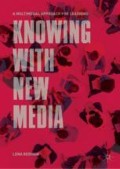Abstract
This chapter discusses the implementation of mobile and stationary digital tools and resources of knowledge-production that are ubiquitously available to the modern learner. This chapter is an expedition into the ‘engine room’ of creative software. It delves into the specifics of the operational modes of digital objects construction. These modes are categorised as:
numerical representation
,
automation
,
modularity
,
variability
and
transcoding
. The chapter examines each of these categories in relation to how deep remixability can be realised and the role it plays in representational
 meaning-making circularity within the context of the Ripple model. This chapter also examines reciprocity between the parallel structure of the mind perception and the instrumentality of the production layers of creative software. The link is examined from the point of view of unified sensory experiences and the unified projection of the production layers, thus, indicating a more precise representation of mental grasp and deeper awareness of sensory data in experiential meaning-making.
meaning-making circularity within the context of the Ripple model. This chapter also examines reciprocity between the parallel structure of the mind perception and the instrumentality of the production layers of creative software. The link is examined from the point of view of unified sensory experiences and the unified projection of the production layers, thus, indicating a more precise representation of mental grasp and deeper awareness of sensory data in experiential meaning-making.
Access this chapter
Tax calculation will be finalised at checkout
Purchases are for personal use only
References
Barbatsis, G. (2005). Reception Theory. In K. Smith, S. Moriarty, G. Barbatsis, K. Kenney (Eds.), Handbook of Visual Communication: Theory, Methods and Media [Kindle Version]. University of South Carolina: Lawrence Erlbaum Associates, Publishers.
Benjamin, W. (1935). The Work of Art in the Age of Mechanical Reproduction [Kindle Version, 2012]. Prism Key Press. Retrieved from: Amazon.com.
Burges, J. (2012). The iPhone Moment, the Apple Brand, and the Creative Consumer: From ‘Hackability and Usability’ to Cultural Generativity. In L. Hjorth, J. Burgess, & I. Richrdson (Eds.), Studying Mobile Media: Cultural Technologies, Mobile Communication, and the iPhone [Kindle Version]. Routledge: Taylor & Francis. Retrieved from: Amazon.com.
Chesher, C. (2012). Between Image and Informaiton: The iPhone Camera in the History of Photography. In L. Hjorth, J. Burgess, & I. Richrdson (Eds.), Studying Mobile Media: Cultural Technologies, Mobile Communication, and the iPhone [Kindle Version]. Routledge: Taylor & Francis. Retrieved from: Amazon.com.
Gibson, J. J. (1979). The Ecological Approach to Visual Perception: Classic Edition [Kindle Version, 2015]. Psychology Press: Taylor & Francis Group. Retrieved from: Amazon.com.
Haraway, D. (2016). Staying with the Trouble: Making Kin in the Chthulucene [Kindle Version]. Duke University Press. Retrieved from: Amazon.com.
Eisenstein, S. (1949). Film Form [Kindle Version]. J. Leyda (Ed. & Trans.). Harcourt, Inc. Retrieved from: Amazon.com.
Irvin, M. (2015). A Model for Generative Combinatoriality. In E. Navas, O. Gallagher, & X. Burrough (Eds.), Routledge Companion to Remix Studies [Kindle Version, loc. 936, 1036]. Taylor & Francis.
Johnson, M. (2007). The Meaning of the Body: Aesthetics of Human Understanding [Kindle Version]. University of Chicago Press.
Kalantzis, M., & Cope, B. (2012). New Learning (Second Edition): Elements of Science of Education [Kindle Version]. Cambridge University Press. Retrieved from: Amazon.com.
Koestler, A. (1989). The Act of Creation. London: Arkana, The Penguin Publishing Group.
Lévi Strauss, C. (1962). The Savage Mind. G. Weidenfield (Trans.). University of Chicago Press.
Manovich, L. (2002a). The Language of New Media [Kindle Version]. The MIT Press. Retrieved from: Amazon.com.
Manovich, L. (2002b). Avant-garde as Software. ArtNodes: UOC. Retrieved from: http://www.uoc.edu/artnodes/espai/eng/art/manovich1002/manovich1002.htmlmanovich1002.htmc.
Manovich, L. (2013). The Software Takes Command: International Text in Critical Media Aesthetics [Kindle Version]. Bloomsbury Academic. Retrieved from: Amazon.com.
McGrenere, J., & Ho, W. (2000). Affordances: Clarifying and Evolving a Concept. Proceedings of Graphics Interface. Montréal, Québec, Canada, 15–17 May 2000, 179–186. Retrieved from: http://graphicsinterface.org/wp-content/uploads/gi2000-24.pdf.
McLuhan, M. (1964). Understanding Media: The Extensions of Man [Kindle Version, 2013]. Gingko Press.
Norman, D. A. (2011). Living with Complexity [Kindle Version]. Cambridge: The MIT Press. Retrieved from: Amazon.com.
Sonvilla-Weiss, S. (2015). Good Artists Copy: Great Artists Steal: Reflections on Cut-Copy-Paste Culture. In E. Navas, O. Gallagher, & X. Burrough (Eds.), The Routledge Companion to Remix Studies [Kindle Version, loc. 2343, 2346]. New York: Routledge; Taylor & Francis.
Tucker, D. M. (2007). Mind from Body: Experience form Neural Structure [Kindle Version]. Oxford University Press. Retrieved from: Amazon.com.
Author information
Authors and Affiliations
Rights and permissions
Copyright information
© 2018 The Author(s)
About this chapter
Cite this chapter
Redman, L. (2018). Engine Room of Creative Software. In: Knowing with New Media. Palgrave Macmillan, Singapore. https://doi.org/10.1007/978-981-13-1361-5_9
Download citation
DOI: https://doi.org/10.1007/978-981-13-1361-5_9
Published:
Publisher Name: Palgrave Macmillan, Singapore
Print ISBN: 978-981-13-1360-8
Online ISBN: 978-981-13-1361-5
eBook Packages: Literature, Cultural and Media StudiesLiterature, Cultural and Media Studies (R0)

